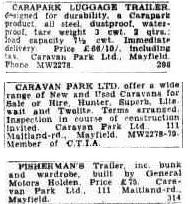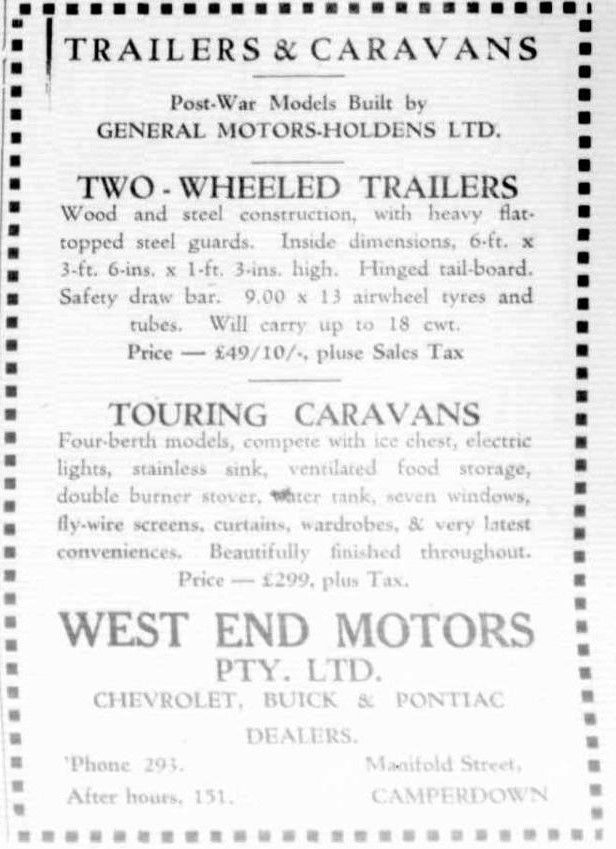|
|
Post by griffin on Sept 21, 2015 20:08:43 GMT 10
General Motors-Holdens Ltd Melbourne. This advertisement was published in The Argus (Melb) on 10 December, 1945 and puts to bed speculation about the GM-H caravan. They at least advertised it, and so far this is the only advertisement I've located for it on Trove.
It was marketed in conjuction with The Myer Emorium who apparently furnished it and displayed it, oh for that Tardis!!
There are probably more questions than enough raised, and to me, WHY?? is the biggest. Why so soon after the war embark on a caravan? They probably weren't to know but petrol rationing was to continue for years, tyres were difficult to obtain and there would be a waiting list of years for new cars depending on what you wanted. In the same paper an article indicated that GM-H were not anticipating their first post war vehicles coming off the assembly line until April 1946!
 1945-12-10- The Argus (Melb) -GMH by viva gt, on Flickr 1945-12-10- The Argus (Melb) -GMH by viva gt, on Flickr
Preston's Motors in Melbourne subsequently advertised box trailers built by GM-H throughout 1946 but I couldn't find anything further about the caravan.
Maybe someone out there has the answers, or has one sitting in their shed?
George
|
|
|
|
Post by Don Ricardo on Sept 22, 2015 21:32:54 GMT 10
G'day Griffin,
What a great find! Thanks for posting the advert. A General Motors-Holdens caravan, furnished by Myer! A must have for every Holden fan. Pity that they don't seem to have gone into production!
The amusing thing, given our previous discussions, is that you're gradually connecting all of Melbourne's prominent familes of the 30's into caravan history. First it was Mrs G J Coles (G J Coles, now Coles Supermarkets) with her Crusader van, then it was G R Nicholas (Nicholas Aspros) with his Romany Road motor caravan built on a Rolls Royce chassis, and now its the GMH caravan furnished by Myer Stores established by Sidney Myer. Who will turn up next? I'm looking forward to your next discovery!!
All that aside, the advert is really interesting. The GMH van looks very similar in style to a lot of pre-war caravans - no radical design developments despite GMH's engineering firepower. I was intrigued by the use of the term 'towing fork' instead of 'A-frame' or something more familiar. I think it's the first time I've seen that term used. Straight off to Cobber's poolroom (Old Tow Couplings) with that one!
Also intriguing was the description of 'sliding fly-wired louvres in the roof for ventilation'. Sounds like on this one the GMH engineers may have found a different approach with a roof hatch that slid rather than lifted up?
You raise the question as to why GMH would be thinking of building caravans so close to the end of the war, and when manufacturing supplies were so hard to come by. I have two theories (and that's all they are). First, that GMH may have built caravans for use by the forces as temporary accommodation for personnel (as did Wolfenden), and having some left over at the end of the war decided to see if there was civilian interest - hence the display in the Myer carpark. Second, that because of the lack of materials and a resulting lack of work for their staff, GMH may have decided to give them a design task which might have some commercial potential once things got back to normal. Do either of those ideas sound feasible do you think?
Don Ricardo
|
|
|
|
Post by Mustang on Sept 23, 2015 18:04:31 GMT 10
Further to the advertisment:
It states to order now (10 dec) for delivery in March, so you would figure they were going to make rather than sell off.
I cant read the price appears to be 359.00 pounds, realativley expensive then? also "available on credit", do times change?
|
|
|
|
Post by griffin on Sept 23, 2015 21:33:35 GMT 10
Hi Don R
We may never know the whys and wherefores of how the van came about and why it doesn't seem to have actually gone into production. As you say there was nothing particularly startling about the design with such resources behind it. I've seen a catalogue of what GM-H produced during the war and don't recall a caravan being part of it, I'll check when I find my copy, but they did build various vans on truck chassis and it might not have been that difficult to transfer that technology to a separate chassis. I can't imagine it was needed to keep the workforce busy, I should have thought the conversion from war time to peace time production and assembly would have been enough and if it wasn't then Lawrence Hartnett who was the MD was hell bent on getting a wholly produced Australian car on the go and had lots of work going on in that area.
The answers may well lie in the GM-H archives which I believe are housed in the Mortlock Library in Adelaide. I understand it comprises some 75 lineal metres of documents which equates to a lot of bits of paper. A couple of friends who have delved into parts of it say there is some amazing stuff there. Unfortunately I don't think I can make the pilgrimage to check it out in the foreseeable future.
George
|
|
|
|
Post by Don Ricardo on Nov 8, 2017 17:13:38 GMT 10
Afternoon all, Back in 2015 when Griffin posted an advertisement for a General Motors-Holden built caravan (see higher up this thread), he commented that: Preston's Motors in Melbourne subsequently advertised box trailers built by GM-H throughout 1946 but I couldn't find anything further about the caravan. Recently when researching some of the history of Caravan Park caravans I came across the following series of adverts printed in the Newcastle Morning Herald and Miners Advocate newspaper on Saturday, 3 December 1949 (page 7):  (Source: National Library of Australia nla.gov.au/nla.news-article134175537 ) The third advertisement caught my eye. It's for a Fisherman's Trailer sold by Caravan Park Ltd, but built by General Motors-Holden. The advert states that the trailer included a bunk and wardrobe, so it sounds as if it was a bit more than a box trailer, perhaps more like a fairly simple camper trailer? So it seems as if GM-H may have had a couple of attempts to enter the 'leisure market', but there are only limited references in the press, so they don't appear to have been very successful. Perhaps they should just have persevered with producing the 48-215? Oh, that's right they did!    Hmm...Fisherman's Trailer, eh...wonder if it was built at Fishermen's Bend...    Don Ricardo |
|
|
|
Post by humpynvan on Nov 9, 2017 7:26:34 GMT 10
Iknow that as part of the war effort General Motors Holden made mobile field offices and Ambulances , Maybe the Fishermans Trailers and Caravans were a way of using up left over army stuff after the war?
|
|
raym
Full Member
  
Posts: 128
|
Post by raym on Feb 8, 2018 21:46:49 GMT 10
Hi All During the war Holden's manufactured timber and plywood boats some were quite large like pt boats etc. As this work came to an end perhaps they were trying to keep these skilled employees in work. They were still making timber frame vehicle bodies up to and most likely during the war so they had a large wood work shop well suited to this type of work They also built some of the old timber Adelaide trams. Ray
|
|
|
|
Post by Don Ricardo on Aug 2, 2020 15:00:10 GMT 10
G’day to you all on a lovely sunny Winter's afternoon, One of the most intriguing episodes in Australian vintage caravan history has to be the production of a caravan built by General Motors-Holden immediately after World War II. An advert for the caravan is shown in Griffin's post that begins this thread. The December 1945 advert includes an artist's impression of the interior of the van and notes that brochures had not yet been printed. Given that we have never seen a photo of a GMH caravan, I have always read the advert as indicating that production was yet to commence, and that the caravan on display in the Myer car park might have just been a prototype. However, Vantoura has always maintained that the GMH caravans were put into production and some were sold. Well, it seems that Vantoura is right! The following advert published in the Victorian Camperdown Chronicle on Tuesday, 5 February 1946 (page 3) offers GMH Touring Caravans for sale at a cost of £299. It seems unlikely that the vans were being advertised if they weren't available to purchase:  (Source: National Library of Australia nla.gov.au/nla.news-article65435019 ) The advert also refers to GMH box trailers. A further advert printed in the Melbourne Argus on Saturday, 25 May 1946 (page 29) also offers GMH trailers:
(Source: National Library of Australia nla.gov.au/nla.news-article22253176 ) Finding a GMH caravan must nearly be the holy grail for some of our Holden loving vintage caravanners! I know that the Holden museum in Maffra would love to get their hands on one. Sadly, a GMH caravan has yet to appear in the wood - unless we just haven't recognised it when it was under our noses. Don Ricardo |
|